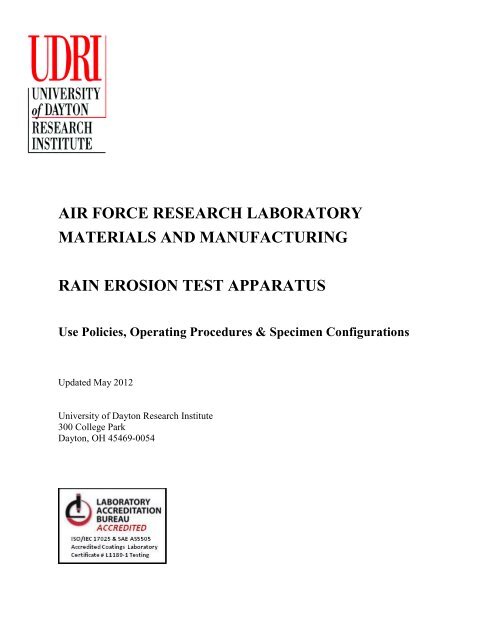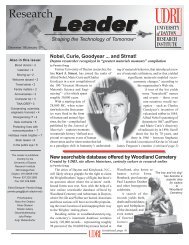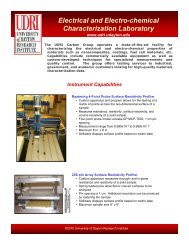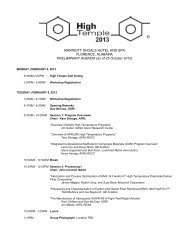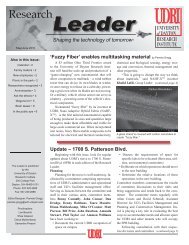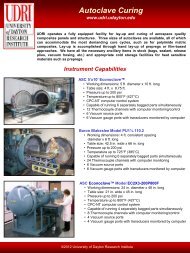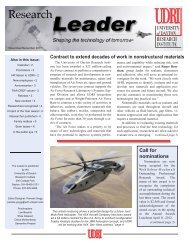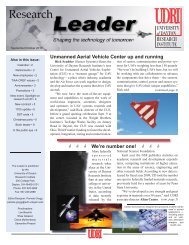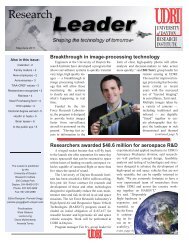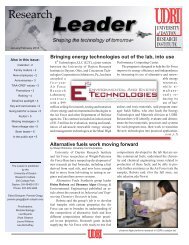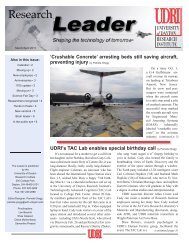User's Guide - University of Dayton Research Institute
User's Guide - University of Dayton Research Institute
User's Guide - University of Dayton Research Institute
Create successful ePaper yourself
Turn your PDF publications into a flip-book with our unique Google optimized e-Paper software.
AIR FORCE RESEARCH LABORATORY<br />
MATERIALS AND MANUFACTURING<br />
RAIN EROSION TEST APPARATUS<br />
Use Policies, Operating Procedures & Specimen Configurations<br />
Updated May 2012<br />
<strong>University</strong> <strong>of</strong> <strong>Dayton</strong> <strong>Research</strong> <strong>Institute</strong><br />
300 College Park<br />
<strong>Dayton</strong>, OH 45469-0054
AFRL Material and Manufacturing Rain Erosion Test Apparatus<br />
TABLE OF CONTENTS<br />
1.0 GENERAL INFORMATION ............................................................................................... 3<br />
2.0 INTRODUCTION.................................................................................................................. 4<br />
3.0 RAIN EROSION TEST APPARATUS ............................................................................... 4<br />
4.0 TYPES OF MATERIALS EVALUATED ........................................................................... 6<br />
5.0 USE POLICIES ...................................................................................................................... 6<br />
5.1 Failure Analysis .................................................................................................................... 6<br />
5.2 Scheduling ............................................................................................................................ 6<br />
5.3 Cancellation Policy .............................................................................................................. 7<br />
5.4 Test Plan ................................................................................................................................ 7<br />
5.5 Specimen Description .......................................................................................................... 8<br />
5.6 Shipment ............................................................................................................................... 8<br />
5.7 Specimen Evaluation ............................................................................................................ 9<br />
5.8 Data Submission ................................................................................................................... 9<br />
5.9 On-Site Visitors .................................................................................................................... 9<br />
6.0 MACH 1.2 RAIN EROSION TEST APPARATUS .......................................................... 10<br />
7.0 THE DEFINITION OF THE ANGLE OF IMPACT ....................................................... 12<br />
8.0 SPECIMENS ........................................................................................................................ 13<br />
8.1 30° Rectangular Specimens ................................................................................................ 13<br />
8.2 30° Disc Specimens ............................................................................................................ 14<br />
8.3 45° Rectangular Specimens ................................................................................................ 15<br />
8.4 45° Disc Specimens ........................................................................................................... 16<br />
8.5 60° Rectangular Specimens ................................................................................................ 18<br />
8.6 60° Disc Specimens ............................................................................................................ 19<br />
8.7 90° Rectangular Specimens ................................................................................................ 20<br />
8.8 90° Disc Specimens ............................................................................................................ 23<br />
8.9 Leading Edge Airfoil Specimens ....................................................................................... 26<br />
8.10 Solid Airfoil Specimens ................................................................................................... 28<br />
Page 2 <strong>of</strong> 31
AFRL Material and Manufacturing Rain Erosion Test Apparatus<br />
1.0 GENERAL INFORMATION<br />
The AFRL Rain Erosion Test Facility (herein referred to as “erosion facility”) is a governmentowned<br />
facility operated by the <strong>University</strong> <strong>of</strong> <strong>Dayton</strong> <strong>Research</strong> <strong>Institute</strong> (UDRI) to serve the<br />
international aerospace community. Access is provided for both military and commercial testing.<br />
Priority <strong>of</strong> testing can usually be determined on a first-come, first-serve basis, but on occasion<br />
this order must be broken for more immediate or emergency evaluations. Failure to comply with<br />
the direction <strong>of</strong> erosion facility personnel can result in cancellation <strong>of</strong> testing. For more<br />
information about the AFRL/UDRI rain erosion test apparatus, contact:<br />
Contractor Personnel<br />
<strong>University</strong> <strong>of</strong> <strong>Dayton</strong> <strong>Research</strong> <strong>Institute</strong><br />
UDRI Erosion Facilities<br />
ATTN: Kathy Hemmerick<br />
300 College Park<br />
<strong>Dayton</strong>, OH 45460-0054<br />
Office: (937) 255-5254<br />
Rain Rig: (937) 255-4289<br />
Katharine.Hemmerick.ctr@wpafb.af.mil<br />
AFRL Government Personnel<br />
AFRL Rain Erosion Test Facility<br />
Coatings Technology Integration Office<br />
AFRL/RXSSO (CTIO)<br />
ATTN: Lynne Pfledderer<br />
2179 12 th Street<br />
Bldg 1661 Room C-110<br />
Wright-Patterson AFB, Ohio 45433-7718<br />
(937) 255-4113<br />
Lynne.Pfledderer@wpafb.af.mil<br />
Page 3 <strong>of</strong> 31
AFRL Material and Manufacturing Rain Erosion Test Apparatus<br />
2.0 INTRODUCTION<br />
The phenomenon known as rain erosion, or the damage to materials caused by the impingement<br />
<strong>of</strong> raindrops at high speed, has long been a concern to the United States Air Force. The Air Force<br />
<strong>Research</strong> Laboratory (AFRL) at Wright-Patterson Air Force Base, Ohio, has conducted and<br />
sponsored research on rain erosion resistant materials since 1947.<br />
In the course <strong>of</strong> rain erosion research over the years, the rotating arm apparatus has provided the<br />
best laboratory simulation <strong>of</strong> the environment for evaluating materials and investigating rain<br />
erosion mechanisms. Typically, in a rotating arm apparatus, test specimens are attached to the tip<br />
<strong>of</strong> a knife-edge propeller-like blade that is rotated horizontally at a specific velocity through a<br />
simulated rainfall. The results <strong>of</strong> rotating arm investigations have been correlated with actual<br />
flight test results, taking into consideration the relative ranking <strong>of</strong> the erosion resistance <strong>of</strong><br />
materials and the mode <strong>of</strong> failure <strong>of</strong> these materials under the influence <strong>of</strong> raindrop<br />
impingement.<br />
UDRI has been involved in rain erosion research and erosion-resistant material development<br />
since 1964. UDRI participated in the design, development, construction, and calibration <strong>of</strong> the<br />
present Rain Erosion Test Apparatus. Over the years, UDRI has conducted more than 82,000<br />
evaluations, representing practically all rain erosion resistant aerospace systems developed over<br />
the past four decades.<br />
The AFRL Rain Erosion Test Apparatus is capable <strong>of</strong> attaining constant velocities between 100<br />
and 900 miles per hour, although current operations are limited to a maximum <strong>of</strong> 650 mph. The<br />
test specimens are exposed to a calibrated one inch per hour simulated rainfall. Raindrop impact<br />
is randomly distributed over the exposed surfaces <strong>of</strong> the test specimens. The test duration can be<br />
designated specific increments (e.g., seconds, minutes or hours) or terminated at the operator’s<br />
discretion when erosion damage is observed.<br />
3.0 RAIN EROSION TEST APPARATUS<br />
The rotating arm apparatus consists <strong>of</strong> an eight foot diameter, double arm blade designed to<br />
produce high tip velocities with zero lift and low drag coefficient. Duplicate test specimens are<br />
mounted at the leading edge tip sections <strong>of</strong> the double rotating arm. The specimens can be<br />
rotated at variable velocities between 100 and 650 MPH.<br />
The double arm blade is mounted horizontally on a vertical drive shaft (Figure 1). The simulated<br />
rainfall is produced by four curved manifold quadrants. Each manifold has 24 equally-spaced<br />
capillaries. De-ionized water is delivered to the four manifold quadrants simultaneously from a<br />
water storage tank. Temperature controlled water then fills the capillaries to produce raindrops.<br />
Page 4 <strong>of</strong> 31
AFRL Material and Manufacturing Rain Erosion Test Apparatus<br />
Drop size and drop rate are controlled by the water temperature, capillary orifice diameter, and<br />
head pressure <strong>of</strong> the water storage tank. Raindrops from the simulation apparatus impact the test<br />
specimens throughout their entire annular path. Drop size and drop rate are approximately 1.8 to<br />
2.2 mm and 6 to 7 drops per second, respectively. Calibration <strong>of</strong> the water supply system is<br />
performed on a regular basis by UDRI personnel.<br />
All functions <strong>of</strong> the apparatus are controlled and monitored from the remote control room.<br />
Instantaneous velocity readout is monitored by an integrating digital voltmeter. Variable speed<br />
operation is possible through the operator’s manual control. Magnetic pickups and high intensity<br />
strobe lights provide stop motion viewing <strong>of</strong> the test specimens under actual test conditions.<br />
Closed-circuit color cameras and monitors allow the operator to visually observe the test<br />
specimens undergoing rain field exposure. Test studies are digitally recorded and available to the<br />
customer for later study.<br />
Figure 1: AFRL Rain Erosion Test Apparatus<br />
1. Double-Arm Blade<br />
2. Mated Test Specimens<br />
3. Vertical Drive Gearbox And Shaft<br />
4. Curved-Manifold Quadrant<br />
5. Water Storage Tank For Rain Simulation<br />
6. Remote-Controlled Cameras<br />
7. Magnetic Pickups For Firing Strobe Lights<br />
8. High-Intensity Strobe Light For Stop-Motion Viewing<br />
9. Variable Speed Readout And Control<br />
10. Strobe Control<br />
11. Remote Color Camera Controls<br />
12. Color Monitors For Specimen Viewing<br />
13. Rain Simulation Control<br />
14. Digital Video Recorder<br />
Page 5 <strong>of</strong> 31
AFRL Material and Manufacturing Rain Erosion Test Apparatus<br />
4.0 TYPES OF MATERIALS EVALUATED<br />
The following is a list <strong>of</strong> typical materials submitted for rain erosion evaluation using the<br />
available configurations:<br />
Composites<br />
Coated metals<br />
Coated composites Ceramics<br />
Plastics<br />
Honeycomb constructions<br />
Coated plastics<br />
Bulk material constructions<br />
Reinforced plastics Glass materials<br />
Metals<br />
Optical materials<br />
5.0 USE POLICIES<br />
5.1 Failure Analysis<br />
Materials evaluated for rain erosion resistance are normally either bulk type or coated. Damage<br />
is evidenced by erosion loss or coating adhesion failure. Such terms as pitting, cratering,<br />
cracking, material loss or fracture, core-crushing, and delamination are used to describe the<br />
progressive performance <strong>of</strong> the materials. These evaluations are reported as a function <strong>of</strong> time in<br />
the test run. Failures near the specimen holder areas are usually taken as anomalies.<br />
The rain erosion environment is more severe than many users initially realize. Often, the<br />
evaluation reports must use the phrase “pre-existing defect” to describe an early failure mode.<br />
5.2 Scheduling<br />
5.2.1 Test Scheduling<br />
Due to the frequent, high demand usage <strong>of</strong> the erosion facility, prospective users are urged to<br />
schedule test dates well in advance. Scheduling is normally accomplished by calling UDRI at<br />
Wright-Patterson Air Force Base; Office: (937) 255-5254, Rain Rig: (937) 255-4289, or FAX<br />
(937) 255-0954.<br />
Address correspondence to:<br />
UDRI Erosion Facilities<br />
ATTN: Kathy Hemmerick<br />
300 College Park<br />
<strong>Dayton</strong>, OH 45460-0054<br />
Office: (937) 255-5254; Rain Rig: (937) 255-4289<br />
Katharine.Hemmerick.ctr@wpafb.af.mil<br />
NOTE: Special arrangements must be made if the test specimens are DOD classified.<br />
Please notify us when scheduling test dates if the test specimens are DOD classified.<br />
Page 6 <strong>of</strong> 31
AFRL Material and Manufacturing Rain Erosion Test Apparatus<br />
5.2.2 Payment Scheduling<br />
Payment arrangements are substantially different for users with a U.S. Government sponsor and<br />
those without a sponsor. To avoid delays or cancellation <strong>of</strong> testing, it is recommended that<br />
payment scheduling be arranged as soon as possible after test scheduling.<br />
5.2.2.1 Users with a U.S. Government Sponsor<br />
Users with a sponsor must contact the Financial Division <strong>of</strong> the Air Force <strong>Research</strong> Laboratory<br />
(AFRL/RXFM) at (937) 255-9765 to arrange payment conditions as soon as possible after<br />
scheduling test dates. This is <strong>of</strong>ten a time-consuming process, but payment conditions must be<br />
arranged before testing can take place. Testing could be delayed or cancelled if payment<br />
conditions are not arranged.<br />
5.2.2.2 Users Without a U.S. Government Sponsor<br />
Users without sponsor operate on a purchase order basis with UDRI. The user company must<br />
submit a “Test Description and Approval Form” agreement (sent by UDRI contracting <strong>of</strong>fice;<br />
[937-229-2919], Point <strong>of</strong> Contact: Tom Menza [Thomas.Menza@udri.udayton.edu]) to be signed<br />
by <strong>of</strong>ficials <strong>of</strong> the user company, UDRI, and AFRL/RXS. The purpose <strong>of</strong> this form is to provide<br />
mutual assurance <strong>of</strong> safety, responsibility, and confidentiality <strong>of</strong> testing and test results. Suitable<br />
time must be allowed to obtain the signatures on this form, especially with the users’ company.<br />
Any discussion or questions regarding this form should be raised as soon as possible after test<br />
scheduling. Testing could be delayed or cancelled if payment conditions are not arranged at least<br />
two weeks prior to the test date(s).<br />
5.3 Cancellation Policy<br />
Users who wish to cancel a scheduled test shall contact UDRI at least two weeks prior to the<br />
scheduled test date. Users who fail to make timely notification will be charged 20% <strong>of</strong> the<br />
scheduled test cost. Exceptions to this charge will be made in the event <strong>of</strong> inclement weather or<br />
personal emergency, or in the event that UDRI can reschedule testing for the dates that had been<br />
reserved for the user. In the event that UDRI must cancel testing because payment conditions<br />
have not been arranged or necessary documents have not been received, the same cancellation<br />
policy will apply.<br />
5.4 Test Plan<br />
Users must submit a test plan to guide and direct their specific test needs. Before scheduling<br />
testing, the users should know the number <strong>of</strong> specimens, geometry, classification, runout time,<br />
and if any intermediate inspections are required. Prospective users are encouraged to discuss<br />
Page 7 <strong>of</strong> 31
AFRL Material and Manufacturing Rain Erosion Test Apparatus<br />
their test plans thoroughly with erosion facility personnel well before the scheduled test date. In<br />
addition to technical matters, guidance can <strong>of</strong>ten be provided regarding the necessary paperwork.<br />
The test plan must include an adequate specimen material description, required velocity and<br />
angular modes, order <strong>of</strong> testing, and a definition <strong>of</strong> test duration, e.g., to initial failure, to<br />
complete failure, length <strong>of</strong> time, etc.<br />
The test plan must be submitted to erosion facility personnel to allow sufficient time for review<br />
and clarification, normally several days prior to the scheduled test date. The test plan serves as a<br />
basis for the evaluation sheet used by the erosion facility operator at the time <strong>of</strong> testing. If the<br />
test plan is late or not submitted, the testing may be delayed or cancelled. It is important to note<br />
that this whirling-arm facility is a double whirling arm and duplicate specimens must be run with<br />
each test. These specimens must be identical in configuration and within a weight differential <strong>of</strong><br />
two grams.<br />
5.5 Specimen Description<br />
It has long been the policy <strong>of</strong> AFRL to maintain a complete database <strong>of</strong> all rain erosion test<br />
results from the erosion facility. This data constitutes the history and progress <strong>of</strong> rain erosion<br />
resistant material development and is accessed only under a strict USAF need basis. Specimens<br />
to be tested must be accompanied by a description sufficient to allow the inclusion <strong>of</strong> the<br />
material and the results into the database. This description can be generic, but it must include at<br />
least the class <strong>of</strong> material(s) being evaluated, with some indication as to material treatment,<br />
coating thickness, etc.<br />
5.6 Shipment<br />
This document describes the many sizes and shapes <strong>of</strong> specimens that can be tested at the erosion<br />
facility. Specimens must conform to one <strong>of</strong> these configurations. It is strongly recommended that<br />
specimens be shipped 7 days in advance <strong>of</strong> the scheduled test date to allow for dimensional<br />
checking. If there is any concern about specimen configurations please contact erosion facility<br />
personnel (Section 1.0 General Information). Ship specimens via Fed Ex or UPS to:<br />
UDRI Erosion Facilities<br />
ATTN: Kathy Hemmerick<br />
AFRL/RXSSO (CTIO)<br />
2700 D Street, Building 1661, Room C110<br />
Wright-Patterson AFB, OH 45433<br />
Page 8 <strong>of</strong> 31
AFRL Material and Manufacturing Rain Erosion Test Apparatus<br />
If test specimens are hand-carried to the erosion facility on the day <strong>of</strong> testing and do not fit the<br />
testing assembly, the test time will be abbreviated or canceled. Because rain erosion test<br />
specimens range from the fragile to the rugged, packaging and shipping should be guided<br />
accordingly. Every effort will be made to maintain the integrity <strong>of</strong> test specimens, although rain<br />
erosion test conditions can compromise this goal.<br />
5.7 Specimen Evaluation<br />
The digital video recorder and stroboscopic lighting system provide continuous visibility <strong>of</strong> the<br />
specimens during testing and enable real-time evaluation. If required, post-test analysis services<br />
are available at an additional cost.<br />
5.8 Data Submission<br />
Following the test and evaluation sequence, a detailed test report is forwarded to the user. All test<br />
results and all test specimens are handled on a strict proprietary basis. No endorsement <strong>of</strong><br />
materials is intended either by the USAF or UDRI.<br />
5.9 On-Site Visitors<br />
Users are welcome to witness the testing <strong>of</strong> their specimens. Due to facility and safety<br />
restrictions, up to three visitors per test are allowed. Prior notification is required and the visitors<br />
must contact contractor or government personnel listed in Section 1.0 General Information to<br />
gain access to Wright-Patterson Air Force Base.<br />
Page 9 <strong>of</strong> 31
AFRL Material and Manufacturing Rain Erosion Test Apparatus<br />
6.0 MACH 1.2 RAIN EROSION TEST APPARATUS<br />
Table 1: Velocity Conversion Table<br />
Page 10 <strong>of</strong> 31
AFRL Material and Manufacturing Rain Erosion Test Apparatus<br />
Table 1 continued: Velocity Conversion Table<br />
Page 11 <strong>of</strong> 31
AFRL Material and Manufacturing Rain Erosion Test Apparatus<br />
7.0 THE DEFINITION OF THE ANGLE OF IMPACT<br />
Figure 2: Angle <strong>of</strong> Impact<br />
Page 12 <strong>of</strong> 31
AFRL Material and Manufacturing Rain Erosion Test Apparatus<br />
8.0 SPECIMENS<br />
8.1 30° Rectangular Specimens<br />
Figure 3: 30° Specimen – Configuration 1<br />
• All dimensions in inches<br />
• Total dimensions include coating thickness if any<br />
• *specimens can be any thickness from 0.125 to a maximum <strong>of</strong> 0.250.<br />
• For specimens under 0.250 thickness, shims must be supplied for both specimens for a<br />
total mounting thickness <strong>of</strong> 0.250.<br />
Note: IR transmitting materials should be a minimum <strong>of</strong> 0.200.<br />
Page 13 <strong>of</strong> 31
AFRL Material and Manufacturing Rain Erosion Test Apparatus<br />
8.2 30° Disc Specimens<br />
Figure 4: 30° Round Specimen – Configuration 1<br />
• All dimensions in inches<br />
• Total dimensions include coating thickness if any<br />
• *Specimens can be any thickness from 0.125 to a maximum <strong>of</strong> 0.625<br />
• For specimens under 0.450 thickness, shims must be supplied for both specimens for a<br />
total mounting thickness <strong>of</strong> 0.450.<br />
• For specimens over 0.450 thickness, shims are not required.<br />
Note: IR transmitting materials should be a minimum <strong>of</strong> 0.200.<br />
Page 14 <strong>of</strong> 31
AFRL Material and Manufacturing Rain Erosion Test Apparatus<br />
8.3 45° Rectangular Specimens<br />
Figure 5: 45° Specimen – Configuration 1<br />
• All dimensions in inches<br />
• Total dimensions include coating thickness if any<br />
• *Specimens can be any thickness from 0.125 to a maximum <strong>of</strong> 0.250.<br />
• For specimens under 0.250 thickness, shims must be supplied for both specimens for a<br />
total mounting thickness <strong>of</strong> 0.250.<br />
Note: IR transmitting materials should be a minimum <strong>of</strong> 0.200.<br />
Page 15 <strong>of</strong> 31
AFRL Material and Manufacturing Rain Erosion Test Apparatus<br />
8.4 45° Disc Specimens<br />
Figure 6: 45° Round Specimen – Configuration 1<br />
• All dimensions in inches<br />
• Total dimensions include coating thickness if any<br />
• *Specimens can be any thickness from 0.125 to a maximum <strong>of</strong> 0.625<br />
• For specimens under 0.450 thickness, shims must be supplied for both specimens for a<br />
total mounting thickness <strong>of</strong> 0.450.<br />
• For specimens over 0.450 thickness, shims are not required.<br />
Note: IR transmitting materials should be a minimum <strong>of</strong> 0.200<br />
Page 16 <strong>of</strong> 31
AFRL Material and Manufacturing Rain Erosion Test Apparatus<br />
Figure 7: 45° Round Specimen – Configuration 2<br />
• All dimensions in inches<br />
• Total dimensions include coating thickness if any<br />
• *Specimens can be any thickness from 0.125 to a maximum <strong>of</strong> 0.500<br />
• For specimens under 0.500 thickness, shims must be supplied for both specimens for a<br />
total mounting thickness <strong>of</strong> 0.500.<br />
Note: IR transmitting materials should be a minimum <strong>of</strong> 0.200<br />
Maximum weight <strong>of</strong> specimen is 130 grams<br />
Page 17 <strong>of</strong> 31
AFRL Material and Manufacturing Rain Erosion Test Apparatus<br />
8.5 60° Rectangular Specimens<br />
Figure 8: 60° Specimen – Configuration 1<br />
• All dimensions in inches<br />
• Total dimensions include coating thickness if any<br />
• Specimens can be any thickness from 0.125 to a maximum <strong>of</strong> 0.250.<br />
• For specimens under 0.250 thickness, shims must be supplied for both specimens for a<br />
total mounting thickness <strong>of</strong> 0.250.<br />
NOTE: IR transmitting materials should be a minimum <strong>of</strong> 0.200.<br />
Page 18 <strong>of</strong> 31
AFRL Material and Manufacturing Rain Erosion Test Apparatus<br />
8.6 60° Disc Specimens<br />
Figure 9: 60° Round Specimen – Configuration 1<br />
• All dimensions in inches<br />
• Total dimensions include coating thickness if any<br />
• *specimens can be any thickness from 0.125 to a maximum <strong>of</strong> 0.625<br />
• For specimens under 0.450 thickness, shims must be supplied for both specimens for a<br />
total mounting thickness <strong>of</strong> 0.450.<br />
• For specimens over 0.450 thickness, shims are not required.<br />
Note: IR transmitting materials should be a minimum <strong>of</strong> 0.200<br />
Page 19 <strong>of</strong> 31
AFRL Material and Manufacturing Rain Erosion Test Apparatus<br />
8.7 90° Rectangular Specimens<br />
Figure 10: 90° Specimen – Configuration 1<br />
• All dimensions in inches<br />
• Total dimensions include coating thickness if any<br />
• Specimens can be any thickness from 0.125 to a maximum <strong>of</strong> 0.500.<br />
• For specimens under 0.500 thickness, shims must be supplied for both specimens for a<br />
total mounting thickness <strong>of</strong> 0.500.<br />
Page 20 <strong>of</strong> 31
AFRL Material and Manufacturing Rain Erosion Test Apparatus<br />
Figure 11: 90° Specimen – Configuration 2<br />
• All dimensions in inches<br />
• Total dimensions include coating thickness if any<br />
• Specimens can be any thickness from 0.125 to a maximum <strong>of</strong> 0.500.<br />
• For specimens under 0.500 thickness, shims must be supplied for both specimens for a<br />
total mounting thickness <strong>of</strong> 0.500.<br />
• Maximum weight <strong>of</strong> specimen is 190 grams.<br />
Page 21 <strong>of</strong> 31
AFRL Material and Manufacturing Rain Erosion Test Apparatus<br />
Figure 12: 90° Specimen – Configuration 3<br />
• All dimensions in inches<br />
• Total dimensions include coating thickness if any<br />
• Specimens can be any thickness from 0.125 to a maximum <strong>of</strong> 0.200.<br />
• For specimens under 0.200 thickness, shims must be supplied for both specimens for a<br />
total mounting thickness <strong>of</strong> 0.200.<br />
Page 22 <strong>of</strong> 31
AFRL Material and Manufacturing Rain Erosion Test Apparatus<br />
8.8 90° Disc Specimens<br />
Figure 13: 90° Round Specimen – Configuration 1<br />
• All dimensions in inches<br />
• Total dimensions include coating thickness if any<br />
• *Specimens can be any thickness from 0.125 to a maximum <strong>of</strong> 0.625<br />
• For specimens under 0.450 thickness, shims must be supplied for both specimens for a<br />
total mounting thickness <strong>of</strong> 0.450.<br />
• For specimens over 0.450 thickness, shims are not required.<br />
Note: IR transmitting materials should be a minimum <strong>of</strong> 0.200<br />
Page 23 <strong>of</strong> 31
AFRL Material and Manufacturing Rain Erosion Test Apparatus<br />
Figure 14: 90° Round Specimen – Configuration 2<br />
• All dimensions in inches<br />
• Total dimensions include coating thickness if any<br />
• Specimens can be any thickness from 0.125 to a maximum <strong>of</strong> 0.625 or specimens under<br />
0.450 thickness, shims must be supplied for both specimens for a total mounting<br />
thickness <strong>of</strong> 0.450.<br />
• For specimens over 0.450 thickness, shims are not required.<br />
Note: IR transmitting materials should be a minimum <strong>of</strong> 0.200<br />
Page 24 <strong>of</strong> 31
AFRL Material and Manufacturing Rain Erosion Test Apparatus<br />
Figure 15: 90° Round Specimen – Configuration 3<br />
• All dimensions in inches<br />
• Total dimensions include coating thickness if any<br />
• *Specimens can be any thickness from 0.125 to a maximum <strong>of</strong> 0.500<br />
• For specimens under 0.500 thickness, shims must be supplied for both specimens for a<br />
total mounting thickness <strong>of</strong> 0.500.<br />
Note: IR transmitting materials should be a minimum <strong>of</strong> 0.200<br />
Maximum weight <strong>of</strong> specimen is 130 grams<br />
Page 25 <strong>of</strong> 31
AFRL Material and Manufacturing Rain Erosion Test Apparatus<br />
8.9 Leading Edge Airfoil Specimens<br />
Figure 16: Composite Leading Edge Airfoil Specimens – Configuration 1<br />
% Chord (Y) Ordinate (X) Abscissa<br />
.00 .00 .000<br />
1.25 .05 .112<br />
2.50 .10 .172<br />
5.00 .20 .250<br />
7.50 .30 .304<br />
10.00 .40 .344<br />
15.00 .60 .400<br />
20.00 .80 .432<br />
25.00 1.00 .439<br />
30.00 1.20 .454<br />
• All dimensions in inches<br />
NOTE: Coatings applied to this airfoil configuration average 0.010 – 0.020 inches in<br />
thickness with a maximum thickness limited to 0.050 inches.<br />
Maximum weight <strong>of</strong> the specimen is 200 grams.<br />
Page 26 <strong>of</strong> 31
AFRL Material and Manufacturing Rain Erosion Test Apparatus<br />
Figure 17: Composite Leading Edge Airfoil Specimens – Configuration 2<br />
• All dimensions in inches<br />
% Chord (Y) Ordinate (X) Abscissa<br />
.00 .00 .000<br />
1.25 .05 .158<br />
2.50 .10 .218<br />
5.00 .20 .296<br />
7.50 .30 .350<br />
10.00 .40 .390<br />
15.00 .60 .446<br />
20.00 .80 .478<br />
25.00 1.00 .485<br />
30.00 1.20 .500<br />
NOTE: Coatings applied to this airfoil configuration average 0.010 – 0.015 inches in<br />
thickness with a maximum thickness limited to 0.040 inches.<br />
Maximum weight <strong>of</strong> the specimen is 200 grams.<br />
Page 27 <strong>of</strong> 31
AFRL Material and Manufacturing Rain Erosion Test Apparatus<br />
8.10 Solid Airfoil Specimens<br />
Figure 18: Solid Airfoil Specimen – Configuration 1<br />
% Chord (Y) Ordinate (X) Abscissa<br />
.00 .00 .000<br />
1.25 .05 .158<br />
2.50 .10 .218<br />
5.00 .20 .296<br />
7.50 .30 .350<br />
10.00 .40 .390<br />
15.00 .60 .446<br />
20.00 .80 .478<br />
25.00 1.00 .485<br />
30.00 1.20 .500<br />
• All dimensions in inches<br />
• Total dimensions include coating thickness if any<br />
• Maximum weight <strong>of</strong> specimen is 123 grams<br />
Page 28 <strong>of</strong> 31
AFRL Material and Manufacturing Rain Erosion Test Apparatus<br />
(X) – chord length = .000 at leading edge<br />
(W) – total width <strong>of</strong> airfoil symmetrical about the centerline<br />
Figure 19: Solid Airfoil Specimen – Configuration 2<br />
• All dimensions in inches<br />
(X) Inches (W) Abscissa<br />
.000 .000<br />
.050 .086<br />
.100 .133<br />
.200 .205<br />
.300 .265<br />
.400 .317<br />
.500 .362<br />
.600 .403<br />
.700 .439<br />
.800 .471<br />
.900 .499<br />
1.000 .524<br />
1.200 .550<br />
• Maximum weight <strong>of</strong> the specimen is 200 grams<br />
Page 29 <strong>of</strong> 31
AFRL Material and Manufacturing Rain Erosion Test Apparatus<br />
Figure 20: Solid Airfoil Specimen – Configuration 3<br />
• All dimensions in inches<br />
• Total dimensions include coating thickness if any<br />
• Maximum weight <strong>of</strong> specimen is 190 grams<br />
Page 30 <strong>of</strong> 31
AFRL Material and Manufacturing Rain Erosion Test Apparatus<br />
Figure 21: Solid Airfoil Specimen – Configuration 4<br />
• All dimensions in inches<br />
• Total dimensions include coating thickness if any<br />
• Maximum weight <strong>of</strong> specimen is 160 grams<br />
Page 31 <strong>of</strong> 31


